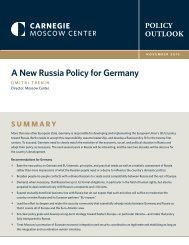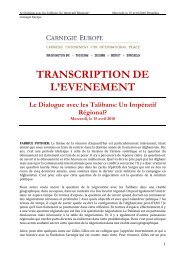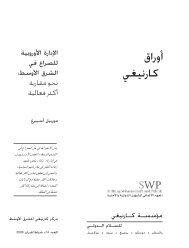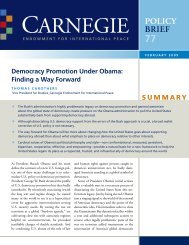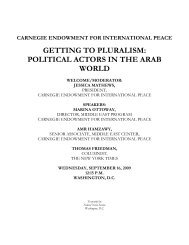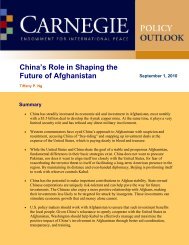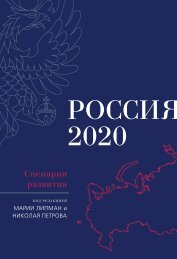Full Text (PDF) - Carnegie Endowment for International Peace
Full Text (PDF) - Carnegie Endowment for International Peace
Full Text (PDF) - Carnegie Endowment for International Peace
Create successful ePaper yourself
Turn your PDF publications into a flip-book with our unique Google optimized e-Paper software.
the initial accumulation of capital. New Russian tycoons quickly and aggressively established<br />
control over assets which were effectively owned by no one. During the era of “gangster<br />
capitalism,” the collapse of Rosneft in its original <strong>for</strong>m was inevitable.<br />
In 1993-1994, new vertically-integrated oil companies (VICs) were <strong>for</strong>med, such as SIDANCO,<br />
Eastern Oil Company and ONACO, and Rosneft was <strong>for</strong>ced to give up many of its upstream and<br />
downstream subsidiaries in favor of these new entities.<br />
In April 1995, Rosneft was trans<strong>for</strong>med into an open JSC by the presidential decree and was<br />
commissioned to per<strong>for</strong>m the following special functions: trust management of state stakes in<br />
companies not included in the new VICs; support <strong>for</strong> the oil industry R&D ef<strong>for</strong>ts; and<br />
representation of state interests in production-sharing agreements (PSAs).<br />
However, Rosneft continued to shrink. In August 1995, it was <strong>for</strong>ced to cede<br />
Nizhnevartovksneftegas to the newly created Tyumen Oil Company. In the same month it<br />
suffered the worst blow when it was deprived of Noyabrksneftegas, Omsknefteorgsyntez (the<br />
most efficient and modern refinery in Russia), Noyabrskgeophisica and Omsknefteproduct in<br />
favor of Sibneft which was allegedly established to help fund Boris Yeltsin's1996 election<br />
campaign.<br />
The September 1995 Government Decree # 971 determined the new composition of Rosneft. 2<br />
However, its hemorrhage did not stop. Thus, Rosneft received the blocking interest of the <strong>for</strong>mer<br />
state geological enterprise Archangelskgeoldobycha (AGD), which held 21 licenses <strong>for</strong> oil fields<br />
and 2 licenses <strong>for</strong> diamond deposits in the Timan-Pechora region. It was assumed that AGD<br />
would partially compensate the state company <strong>for</strong> the loss of Noyabrskneftegas. Rosneft was<br />
also interested in AGD because the latter was the co-owner of the JV Polar Lights (see below).<br />
However, it turned out that the controlling interest in AGD was held by MAPO-Bank, and<br />
Rosneft could not manage its cash and crude flows. Unable to tighten its grip over AGD, Rosneft<br />
purchased from it a 20% stake in Polar Lights. Having fulfilled its role of an intermediary,<br />
MAPO-Bank transferred its stake in Archangelskgeoldobycha to LUKOIL in 1997. 3<br />
In downstream, Rosneft was even more of a failure than in upstream. The cumulative output of<br />
its three refineries was only 4.7 million tons in 1996, less than half of the amount of oil Rosneft<br />
produced. In 1997, its Krasnodarnefteorgsyntez was to be sold off to repay tax obligation of $32<br />
million - quite a modest sum as compared to other oil companies' debts. It was somewhat<br />
surprising that the government would choose to draw the line with respect to a subsidiary of<br />
Rosneft rather than that of debt-ridden privatized companies which were able to successfully<br />
lobby decisions in their favor. 4<br />
In addition, Rosneft lost the Moscow refinery and Mosneftepoduct that it had under trust<br />
management in accordance with the ordinance # 971. However, the Mayor of Moscow Yuri<br />
Luzhkov began to claim that Rosneft could exert price pressure on the Moscow fuel market<br />
2 Purneftegas, Sakhalinmorneftegas, Krasnodarneftegas, Stavropolneftegas, Termneft, Dagneft,<br />
Archangelskgeoldobycha, Kalmneft; Krasnodarnefteorgsyntez, Komsomolsk, Tuapse and<br />
Moscow; 16 petroleum products distributors.<br />
3 Since Rosneft held a blocking interest in AGD, LUKOIL could not actively invest in the development of the<br />
company and tried to consolidate its shares. Rosneft refused to sell or exchange its stake. The struggle between them<br />
continued <strong>for</strong> a long time. However, LUKOIL understood that in the new political situation it was better to live in<br />
peace with the strengthening state company. A compromise was reached in the late 2002 when they swapped the<br />
assets under disputes (see Oil and Capital, # 10, 2004, p. 116).<br />
4 After three unsuccessful attempts, Krasnodarnefteorgsyntez was sold in October 2000.<br />
2




